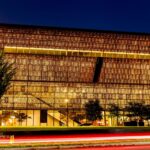
The National Museum of African American History and Culture (NMAAHC) is known for its stunning architecture and powerful, immersive exhibits. More than 600,000 visitors experienced the NMAAHC – the newest Smithsonian museum – in the first three months of its opening in Washington, D.C. During the COVID pandemic, the museum wondered how it could best reach audiences unable to visit in person. Enter Baltimore-based tech company Fearless and a team of UMBC alumni bridging computing and the arts.
Fearless, founded by Delali Dzirasa ‘04, computer engineering, led the development of the Searchable Museum to complement the NMAAHC’s “Slavery and Freedom” exhibition. The Fearless and NMAAHC teams worked together to reimagine this exhibit specifically for online audiences.
The Smithsonian’s announcement of the new platform notes, “Over a year in the making, the Searchable Museum initiative is one of the museum’s largest digital undertakings, bringing the museum’s evocative content and immersive in-person visitor experience into homes around the world.”
Reaching students where they are
The Searchable Museum has notably increased access to the NMAAHC exhibit materials, enabling people from around the world to immerse themselves in African American history and navigate critical conversations. A particularly important audience for the museum is K-12 students, whose class field trips to Washington, D.C. have been sharply curtailed by COVID.
 Delali Dzirasa in the Fearless office space. Photo by Marlayna Demond ’11 for UMBC.
Delali Dzirasa in the Fearless office space. Photo by Marlayna Demond ’11 for UMBC.
The Fearless team designed the Searchable Museum with this audience in mind, and website data reveals they have succeeded in reaching that audience. Google Classrooms is one of the top ways that visitors have accessed the Searchable Museum.
“This is a dream project for us, and we knew we had to put together a world-class team,” says Dzirasa. “It was very important to us and the museum team that this be an experience for everyone. The types of interactive features we included are meant to be inclusive of as many people and devices as possible.”
Collaboration and innovation
Dzirasa and UMBC alumni and Fearless COO John Foster ‘04, computer engineering, convened a team of 16 Fearless employees who have worked on the two year project, including UMBC alumni Avery Smith ‘03, visual arts; Bill Streckfus ‘06, computer science; and Evan Rittenhouse ‘17, computer science.
“Fearless helped extend the museum’s reach to the online world, which required sensitivity. It was both a responsibility and a pleasure to make sure the museum’s stories of perseverance, tragedy, and triumph were carefully transmitted through an online medium, directly to the hearts of each visitor of the site,” explains Smith, a software engineer at Fearless.
 Avery Smith. Photo courtesy of Smith.
Avery Smith. Photo courtesy of Smith.
“Personally speaking, the NMAAHC is a landmark institution that provides a national record of activity of my ancestors and contemporaries,” says Smith. “It is extremely important that many of our artifacts and accomplishments are adequately surfaced to a global audience.”
Smith shares, “Fearless believes that the internet is a major tool for innovation, collaboration and critical thought. Helping to chronicle this extremely important segment of American history is our way of contributing to a fairer, healthier world, with an internet that is even more useful for even more people.”
Expanding access to African American stories
Dzirasa, Smith, and the rest of the Fearless team look forward to collaborating with the NMAAHC to translate more exhibits to the Searchable Museum platform.
 A photo of the Searchable Museum interface. Courtesy of the National Museum of African American History and Culture.
A photo of the Searchable Museum interface. Courtesy of the National Museum of African American History and Culture.
“Visiting NMAAHC is a life-changing experience, but I know not everyone will be able to go to Washington, D.C. to see the exhibitions in person. It was very important to us that we preserve and enhance the emotional storytelling people experience when they visit the museum and bring it online,” says Dzirasa.
“What you see today is version one, and we’re already making plans for what comes next,” he notes. “We are learning and taking feedback to make the next versions even better. As more exhibitions are added to the Searchable Museum, you’ll be able to access and experience hundreds of years of the African American story from anywhere in the world.”
Kevin Young, Andrew W. Mellon Director of the museum, shares, “Allowing the public to virtually revisit the originating struggle for American freedom in the ‘Slavery and Freedom’ exhibition reminds us of the centrality of the African American journey to the American experience—a story of triumph, resilience and joy over the centuries.”
Banner image: The National Museum of African American History and Culture. Photo by Angela N., Flickr CC by 2.0.





